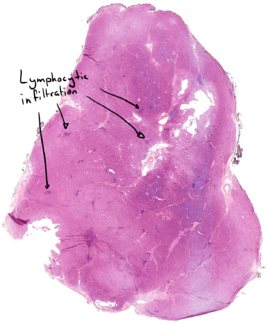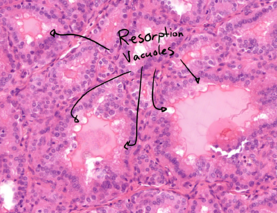27. Graves disease: Difference between revisions
(Created page with "'''Staining''': HE '''Organ''': Thyroid '''Description''': Normal thyroid follicles are replaced by two types of abnormal follicles: * Hypertrophic follicles * Follicles with resorption vacuoles The follicular cells of the hypertrophic follicles are hypertrophic (large). These follicles have no visible lumen or colloid substance. Due to the hyperactivity of the thyroid follicular cells these cells will quickly consume colloid. This leaves behind small “vacuoles...") |
No edit summary |
||
| (2 intermediate revisions by the same user not shown) | |||
| Line 1: | Line 1: | ||
'''Staining''': HE | [[File:Graves disease - overview.png|thumb|Overview|325x325px]]'''Staining''': HE | ||
'''Organ''': Thyroid | '''Organ''': Thyroid | ||
'''Description''': | '''Description''': Normal thyroid follicles are replaced by two types of abnormal follicles: | ||
Normal thyroid follicles are replaced by two types of abnormal follicles: | |||
* Hypertrophic follicles | * Hypertrophic follicles | ||
* Follicles with resorption vacuoles | * Follicles with resorption vacuoles | ||
The follicular cells of the hypertrophic follicles are hypertrophic (large). These follicles have no visible lumen or colloid substance. | The follicular cells of the hypertrophic follicles are hypertrophic (large). These follicles have no visible lumen or colloid substance. Due to the hyperactivity of the thyroid follicular cells these cells will quickly consume colloid. This leaves behind small “vacuoles” that line the follicular cells. It looks like the follicular cells “take a bite” out of the colloid substance. | ||
Due to the hyperactivity of the thyroid follicular cells these cells will quickly consume colloid. This leaves behind small “vacuoles” that line the follicular cells. It looks like the follicular cells “take a bite” out of the colloid substance | |||
'''Diagnosis''': Graves disease | As Graves disease is an autoimmune disease, which is chronic by definition, lymphocytic infiltration is present as well.[[File:Graves disease - resorption vacuoles.png|thumb|Resorption vacuoles|277x277px]]'''Diagnosis''': Graves disease | ||
'''Risk factors:''' | '''Risk factors:''' | ||
| Line 25: | Line 19: | ||
Nothing special. | Nothing special. | ||
[[File:Graves disease - hypertrophic follicles.png|thumb|Hypertrophic follicles|left]] | |||
[[File:Graves disease - lymphocytic infiltrate.png|thumb|Lymphocytic infiltrate|252x252px]] | |||
[[File:Graves disease - hypertrophic follicles.png | |||
[[File:Graves disease - lymphocytic infiltrate.png | |||
[[Category:Pathology 2 - Histopathology slides]] | [[Category:Pathology 2 - Histopathology slides]] | ||
Latest revision as of 14:15, 7 July 2024

Staining: HE
Organ: Thyroid
Description: Normal thyroid follicles are replaced by two types of abnormal follicles:
- Hypertrophic follicles
- Follicles with resorption vacuoles
The follicular cells of the hypertrophic follicles are hypertrophic (large). These follicles have no visible lumen or colloid substance. Due to the hyperactivity of the thyroid follicular cells these cells will quickly consume colloid. This leaves behind small “vacuoles” that line the follicular cells. It looks like the follicular cells “take a bite” out of the colloid substance.
As Graves disease is an autoimmune disease, which is chronic by definition, lymphocytic infiltration is present as well.

Diagnosis: Graves disease
Risk factors:
- Young females
Theory:
Nothing special.


